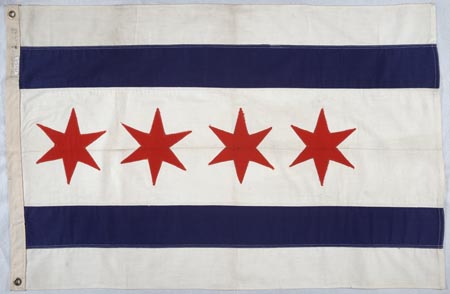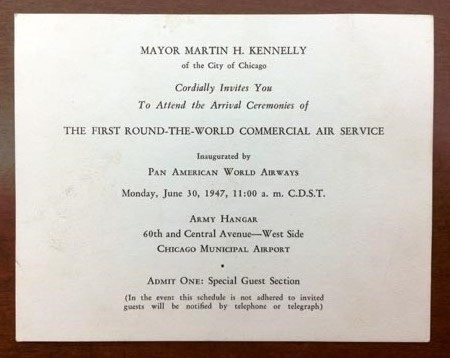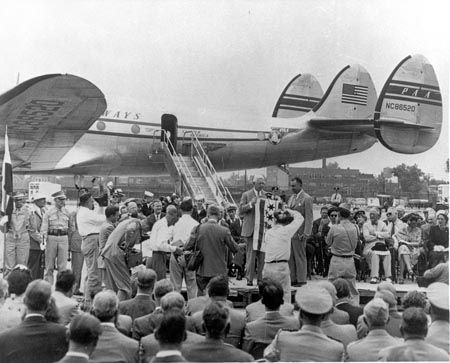April 4, 2017 marks the 100th anniversary of the Chicago flag, one of the city’s most familiar symbols. To mark the occasion, CHM is hosting a special event that evening, featuring two flags from the Museum’s collection. The first is from 1920 and has two red stars, as originally designed by Wallace Rice to represent the Great Chicago Fire of 1871 and the 1893 World’s Columbian Exposition. The second has two additional stars that were added in the 1930s to signify Fort Dearborn and the 1933–34 A Century of Progress International Exposition. This flag looks more familiar, but it has a surprising story to tell.

The Chicago flag that circumnavigated the world, c. 1947. CHM, ICHi-066334
In early 1947, Juan Trippe, president of Pan American World Airways, began lobbying Congress to form an exclusive, unified airline known as Community Company for international travel with his company at the core. Opponents claimed this would create a monopoly and defeated the measure. Undaunted, Trippe continued to advocate his cause with influential friends and associates. He arranged an around-the-world press flight for leading newspaper publishers from across the country, including Marshall Field III of the Chicago Sun and J. L. Maloney of the Chicago Tribune. Also on board was a small Chicago flag, brought by Trippe himself to help promote Chicago’s prominent place in the future of aviation.
On June 17, 1947, thousands cheered as Pan American’s four-engine Lockheed plane named America took off from LaGuardia Airport in Queens, New York, in what became the first scheduled commercial around-the-world flight in history. It encompassed more than 20,000 miles in about ninety hours of flying time over thirteen days—a snail’s pace by today’s standards but astonishing at the time. The flight made seventeen stops, including Shannon, London, Istanbul, Dhahran, Calcutta (today Kolkata), Shanghai, Tokyo, Guam, Honolulu, and San Francisco. At certain stops, such as London and Calcutta, the delegation met with local officials to discuss the future of world air travel.

Official invitation to the arrival ceremonies for the America, 1947. Photograph by Museum staff
At 11:00 a.m. on June 30, 1947, America touched down at Chicago Municipal Airport, renamed Midway Airport in 1949, before returning to New York, its final destination. An official delegation of seventy-five was on hand to greet them, along with a thirty-piece brass band from Fort Sheridan and scores of interested Chicagoans. The ceremony began with comments from Merrill C. Meigs, former publisher of the Chicago Herald and Examiner and longtime champion of commercial aviation. Meigs expressed the thoughts of many when he said: “We who are engaged in the development of aviation in the Chicago area are well aware of the fact that this city is the natural, logical, central air gateway for American air transportation, in both domestic and international service.” When he finished speaking, Trippe presented the well-traveled city flag to Mayor Martin H. Kennelly, who in turn presented it to Paul Angle, director of the Chicago Historical Society.

Juan Trippe (standing at right) presents the Chicago flag that traveled around the world to Mayor Martin H. Kennelly, June 30, 1947. CHM, ICHi-026495
From this small but auspicious beginning, Chicago became a major hub of international travel. In 2016 alone, more than twelve million international passengers passed through Midway and O’Hare Airports and their numbers are expected to increase. The little flag that made the first such journey, however, is forever grounded—but safely in our care.